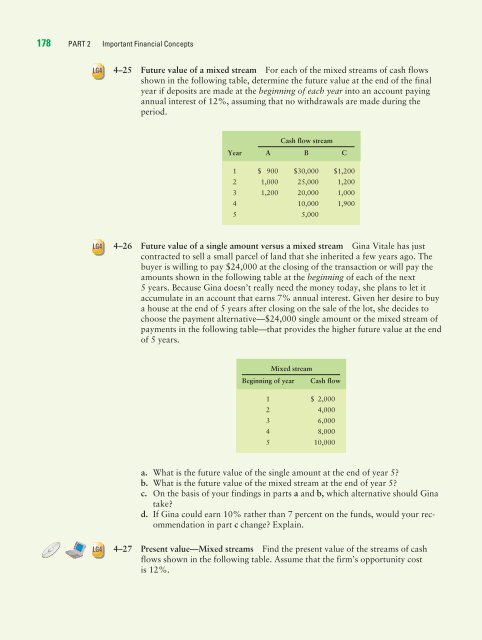Read the Chapter 4 E-Book
Read the Chapter 4 E-Book
Read the Chapter 4 E-Book
You also want an ePaper? Increase the reach of your titles
YUMPU automatically turns print PDFs into web optimized ePapers that Google loves.
178 PART 2 Important Financial Concepts<br />
LG4<br />
LG4<br />
LG4<br />
4–25 Future value of a mixed stream For each of <strong>the</strong> mixed streams of cash flows<br />
shown in <strong>the</strong> following table, determine <strong>the</strong> future value at <strong>the</strong> end of <strong>the</strong> final<br />
year if deposits are made at <strong>the</strong> beginning of each year into an account paying<br />
annual interest of 12%, assuming that no withdrawals are made during <strong>the</strong><br />
period.<br />
Year A<br />
Cash flow stream<br />
B C<br />
1 $ 900 $30,000 $1,200<br />
2 1,000 25,000 1,200<br />
3 1,200 20,000 1,000<br />
4 10,000 1,900<br />
5 5,000<br />
4–26 Future value of a single amount versus a mixed stream Gina Vitale has just<br />
contracted to sell a small parcel of land that she inherited a few years ago. The<br />
buyer is willing to pay $24,000 at <strong>the</strong> closing of <strong>the</strong> transaction or will pay <strong>the</strong><br />
amounts shown in <strong>the</strong> following table at <strong>the</strong> beginning of each of <strong>the</strong> next<br />
5 years. Because Gina doesn’t really need <strong>the</strong> money today, she plans to let it<br />
accumulate in an account that earns 7% annual interest. Given her desire to buy<br />
a house at <strong>the</strong> end of 5 years after closing on <strong>the</strong> sale of <strong>the</strong> lot, she decides to<br />
choose <strong>the</strong> payment alternative—$24,000 single amount or <strong>the</strong> mixed stream of<br />
payments in <strong>the</strong> following table—that provides <strong>the</strong> higher future value at <strong>the</strong> end<br />
of 5 years.<br />
Mixed stream<br />
Beginning of year Cash flow<br />
1 $ 2,000<br />
2 4,000<br />
3 6,000<br />
4 8,000<br />
5 10,000<br />
a. What is <strong>the</strong> future value of <strong>the</strong> single amount at <strong>the</strong> end of year 5?<br />
b. What is <strong>the</strong> future value of <strong>the</strong> mixed stream at <strong>the</strong> end of year 5?<br />
c. On <strong>the</strong> basis of your findings in parts a and b, which alternative should Gina<br />
take?<br />
d. If Gina could earn 10% ra<strong>the</strong>r than 7 percent on <strong>the</strong> funds, would your recommendation<br />
in part c change? Explain.<br />
4–27 Present value—Mixed streams Find <strong>the</strong> present value of <strong>the</strong> streams of cash<br />
flows shown in <strong>the</strong> following table. Assume that <strong>the</strong> firm’s opportunity cost<br />
is 12%.

















